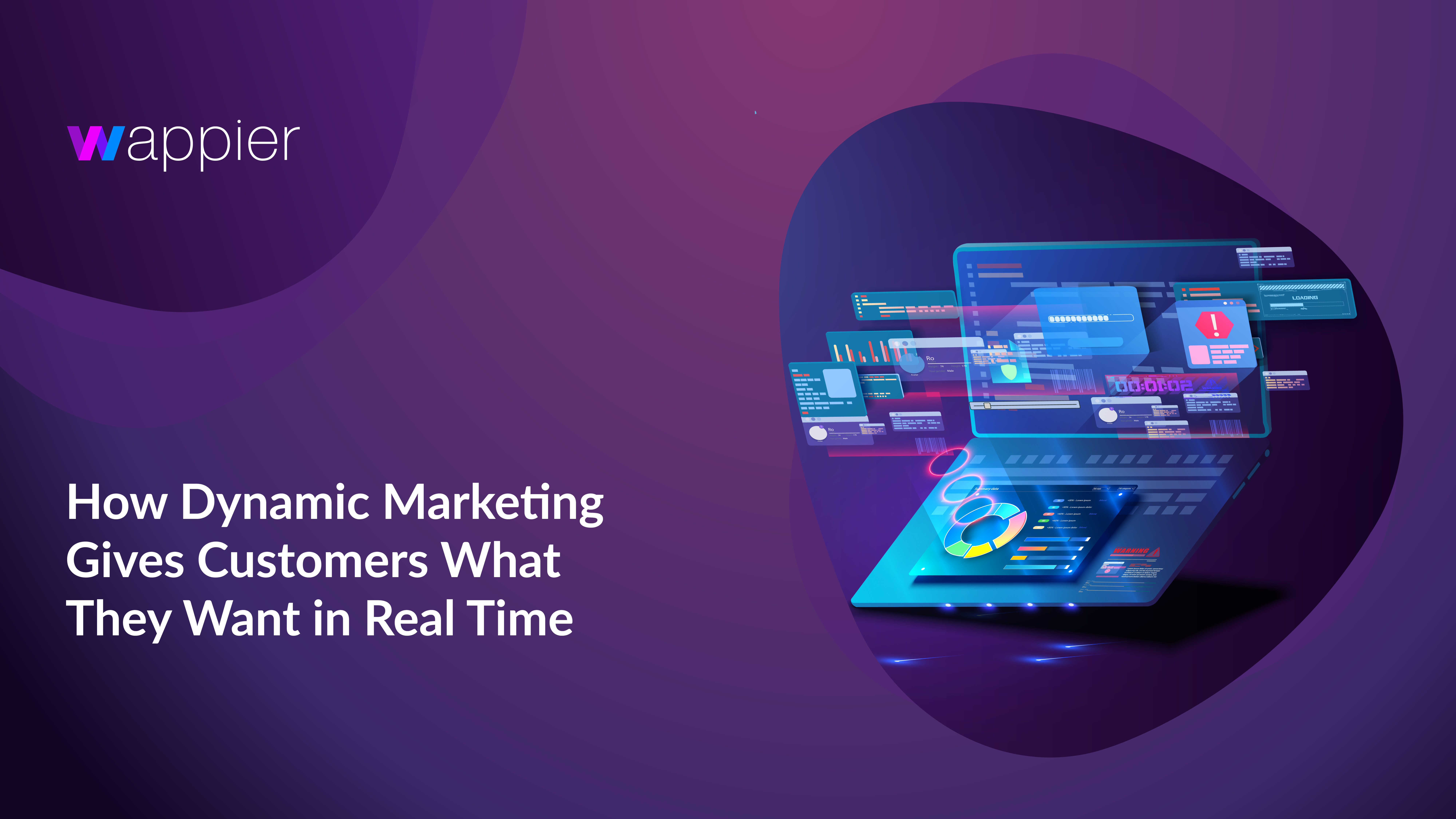Personalization is the norm in today’s marketing world. Consumers expect it, and marketers that don’t deliver are sure to fall out of favor. Generalized marketing has become so ubiquitous that it’s actively turning people off; 90% of consumers say they feel annoyed by marketing messages that are not personalized for them in some way. Dynamic marketing is a promising strategy for that consumer reality, since it allows companies to deliver highly personalized messaging that is relevant for each customer’s specific journey.
In this article, we’ll explore the definition of dynamic marketing, best practices to implement the approach, and the key benefits of giving customers what they want in real time.
Jump to a section…
What Is Dynamic Marketing?
Dynamic marketing is a strategy that uses customer data to deliver the most personalized and relevant ads possible. Instead of a one-size-fits-all approach, dynamic marketing takes into consideration the specifics of a particular buyer’s journey. It targets the messaging, tone of voice, visuals, and recommendations that a consumer receives based on their past behavior like what actions they’ve taken, what their preferences are, and where their interests lie. Advanced strategies also account for individual metrics like probability to churn, probability to convert, and lifetime customer value.
Dynamic marketing concepts are geared toward creating excellent customer experiences that leave each individual consumer with the sense that the brand they are interacting with truly understands them.
Specifically, dynamic marketing systems take into account where customers fall within the sales funnel in order to deliver messaging that is appropriate for their position in the decision-making process. The ways consumers have interacted with a brand so far play a major role in what they will find most helpful next. For example:
- Top of the funnel: Someone visiting your website for the first time needs a general introduction to the brand, the problems it solves, and the solutions it offers. A heavy-handed discount offering would seem out of place for that first-time visitor.
- Mid-funnel: If a consumer spends time selecting items on your website before abandoning their cart, it might be appropriate to send them an email an hour or two later reminding them of the items they selected, suggesting other popular choices, or highlighting available promotions.
- Bottom of the funnel: Once a prospect has become a customer by making a purchase, they don’t need to be sold on the benefits of your brand, anymore. They’ll benefit more from an invitation to share their feedback, an opportunity to spread the word, or a discount on future purchases.
These types of personalization based on the specific needs of an individual consumer are at the core of dynamic marketing. Instead of making your marketing strategy appealing to as many people as possible, the dynamic approach means drilling down into the specifics of each consumer’s needs.
How Does Dynamic Marketing Work?
There are many ways to implement this approach, but there are a few best practices that underlie any dynamic marketing strategy:
Create customer profiles
How can you serve someone you don’t understand? Data-backed customer profile analysis will help create a more defined understanding of your target consumer. Getting to know the details of your ideal customers will help you deliver more effective personalization through dynamic marketing.
Focus on qualified leads
Determining the common behaviors of your most loyal customers makes it easier to direct the bulk of your marketing budget toward worthwhile prospects. Take into account average cost per acquisition, retention rates, and behavior patterns in order to qualify leads and anticipate where your dynamic marketing spend will have the greatest impact.
Improve data collection
Companies sometimes worry that implementing dynamic marketing will require them to collect more data, but the reality is that it’s more important to collect better data and make better use of the data you already have. Aggregating and analyzing the right data points will lead to valuable insights about your audience that you can then use to inform your dynamic marketing strategy.
Streamline the experience
While dynamic marketing allows brands to deliver delightful and highly personalized messaging, it also presents an opportunity to iterate and improve based on the data and feedback you receive. If a higher than normal percentage of customers are abandoning their carts, perhaps your checkout process is too complicated. If consumers don’t regularly become repeat customers, look for ways to transform one-time buyers into long-time fans.
What Are The Benefits Of Dynamic Marketing?
Dynamic marketing gives customers what they want and moves the needle for companies at the same time. These are just a few of the benefits of seeking out dynamic marketing services for your brand:
Consumers expect personalization
According to Epsilon, 80% of consumers are more likely to do business with brands that offer personalized experiences. Dynamic marketing puts that kind of personalization within reach for companies by leveraging the data they already have access to. Customer interactions — whether they lead to sales or not — all provide valuable insights into what consumers want, what they need, and what will make the difference for them in terms of both conversion and long-term relationship building.
Change-proof flexibility
The ability to fine-tune your marketing strategy based on the specifics of each consumer’s behavior creates immense flexibility. In this way, dynamic marketing allows for a level of responsiveness that is virtually future-proof — instead of being stuck in long-term cascading plans untethered to the realities of the rapidly changing world, a dynamic approach allows marketers to pivot whenever necessary based on changes at the level of the individual consumer or in broader societal trends.
Data-backed decisions
Designing a marketing strategy based solely on of-the-moment trends, overarching business goals, or good ideas that come up in a given meeting is ineffective, to say the least. That’s especially true when it comes to planning long-term strategies, say annually, or quarterly. Industry shifts, political moves, and economic changes can all upend even the best laid plans, so it’s important to anchor any marketing strategy in hard facts. Dynamic marketing does even better by taking those factual cues from consumers themselves, basing every marketing decision you make on the realities expressed by the people to whom you are selling.
Automation powers scalability
It can seem intimidating to launch individually personalized marketing at scale, especially for large companies and brands experiencing rapid growth. One of the key benefits of dynamic marketing is that it allows for automation, which enables brands to deliver highly personalized messaging to individual consumers based on their specific behaviors all at scale. Eliminating costly and inefficient manual processes through dynamic marketing automation doesn’t just bring down overhead, it actively helps marketers be better at their jobs.
Not sure how to introduce dynamic marketing to your business strategy? wappier can help with that! Our machine learning-powered engine produces personalized recommendations by assessing individual metrics including probability to churn, probability to convert, and lifetime value. Through a dynamic assembly of custom creative and real-time personalized offer generation, each individual is served a one-of-a-kind dynamic marketing experience.
If you’re interested in a partner that can help you create high-performance dynamic marketing systems, then be sure to reach out.







